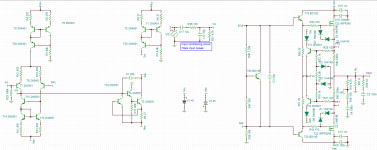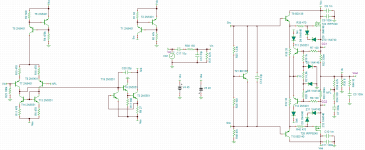Hi everyone,
I'm new at solid state amplifier design, I've made this designs based on Bob Cordell's book, but I don't know if they work because my last designs were based in Randy Slone's book and they suffer from quiescent bias instability.
These two class B amplifiers have very poor THD characteristics, the amplifier at the picture named "Amp1" has a THD1 performance of ~0.0027%, and a THD20 of ~0.05% at 60 W of continuous average power, the amplifier at picture named "Amp2" has a THD1 performance of ~0.0025%, and a THD20 of ~0.05%. From 1W to 80 W of continuous average power both amplifiers have 0.01% (THD1 max) and 0.2% (THD20 max) those are very poor characteristics, I don't know what I have made wrong but this values are really terrible, even my stereo HiFi is better with an STK4231II power IC which has got bootstraped VA, and 0.001% THD1 and less than 0.01% THD20. The short circuit protection circuit seems to work very well in simulations, but I don't know if that circuit works in the real world.
Could someone help me solving this problem?
Thank you very much for your attention,
Best regards,
Daniel Almeida
I'm new at solid state amplifier design, I've made this designs based on Bob Cordell's book, but I don't know if they work because my last designs were based in Randy Slone's book and they suffer from quiescent bias instability.
These two class B amplifiers have very poor THD characteristics, the amplifier at the picture named "Amp1" has a THD1 performance of ~0.0027%, and a THD20 of ~0.05% at 60 W of continuous average power, the amplifier at picture named "Amp2" has a THD1 performance of ~0.0025%, and a THD20 of ~0.05%. From 1W to 80 W of continuous average power both amplifiers have 0.01% (THD1 max) and 0.2% (THD20 max) those are very poor characteristics, I don't know what I have made wrong but this values are really terrible, even my stereo HiFi is better with an STK4231II power IC which has got bootstraped VA, and 0.001% THD1 and less than 0.01% THD20. The short circuit protection circuit seems to work very well in simulations, but I don't know if that circuit works in the real world.
Could someone help me solving this problem?
Thank you very much for your attention,
Best regards,
Daniel Almeida
Attachments
Last edited:
Wow, 0.02% is already good.
You can add VAS cascode, if you care more about THD than sound quality.
Keep thd at maximum allowable (such as 0.02%) while improving other parameters.
You can add VAS cascode, if you care more about THD than sound quality.
Keep thd at maximum allowable (such as 0.02%) while improving other parameters.
Hello Jay and thank you very much for your support,
What you mean with other parameters, could you be more specific?
Best regards,
Daniel Almeida
What you mean with other parameters, could you be more specific?
Best regards,
Daniel Almeida
These two class B amplifiers have very poor THD characteristics, the amplifier at the picture named "Amp1" has a THD1 performance of ~0.0027%, and a THD20 of ~0.05% at 60 W of continuous average power,
You must be joking.
You have quoted a lot of distortion numbers which don't relate to any particular amplifier or basic design.
As you say you are new at audio amplifiers, it seems unlikely that what you quote are measured figures,
so what are you really comparing?
BTW, where does the specification on the hybrid module come from, a brochure? The Sanyo datasheet
doesn't come near what you suggest for the basic module (STK 4321 II - 0.3% THD1 @ 1W).
If you are going to quote specifications, make sure they really are comparable and not just hype,
simulator or massaged figures extracted from graphs. Specs. ain't specs. unless they are properly qualified.
As you say you are new at audio amplifiers, it seems unlikely that what you quote are measured figures,
so what are you really comparing?
BTW, where does the specification on the hybrid module come from, a brochure? The Sanyo datasheet
doesn't come near what you suggest for the basic module (STK 4321 II - 0.3% THD1 @ 1W).
If you are going to quote specifications, make sure they really are comparable and not just hype,
simulator or massaged figures extracted from graphs. Specs. ain't specs. unless they are properly qualified.
Hi everyone.
That values come from simulations, but the THD characteristics for STK4231II I've seen in a graph from an old brochure. I don't know if those designs are functional because all the results came from simulations, do you think that's a good idea trying to build this designs or it's just a waste of time?
Best regards,
Daniel Almeida
That values come from simulations, but the THD characteristics for STK4231II I've seen in a graph from an old brochure. I don't know if those designs are functional because all the results came from simulations, do you think that's a good idea trying to build this designs or it's just a waste of time?
Best regards,
Daniel Almeida
Last edited:
I think you can build from those simulations.Hi everyone.
That values come from simulations, but the THD characteristics for STK4231II I've seen in a graph from an old brochure. I don't know if those designs are functional because all the results came from simulations,
do you think that's a good idea trying to build this designs or it's just a waste of time?
Best regards,
Daniel Almeida
After all it comes from examples in Bob Cordell book.
So, it should work.
I think those numbers you got are very good.
They are typical from many modern power amplifiers.
Hi everyone.
That values come from simulations, but the THD characteristics for STK4231II I've seen in agraph from an old brochure. I don't know if those designs are functional because all the results came from simulations, do you think that's a good idea trying to build this designs or it's just a waste of time?
Best regards,
Daniel Almeida
That values come from simulations, but the THD characteristics for STK4231II I've seen in agraph from an old brochure. I don't know if those designs are functional because all the results came from simulations, do you think that's a good idea trying to build this designs or it's just a waste of time?
Best regards,
Daniel Almeida
Simulation is a powerful and very useful tool, but after sometime you must grab a soldering iron and build something "in the flesh".
Otherwise you never correlate what you draw and what you hear.
Both aspects are necessary. 🙂
Otherwise you never correlate what you draw and what you hear.
Both aspects are necessary. 🙂
- Status
- Not open for further replies.
- Home
- Amplifiers
- Solid State
- Vertical Mosfet Amplifier with high THD distortion levels

